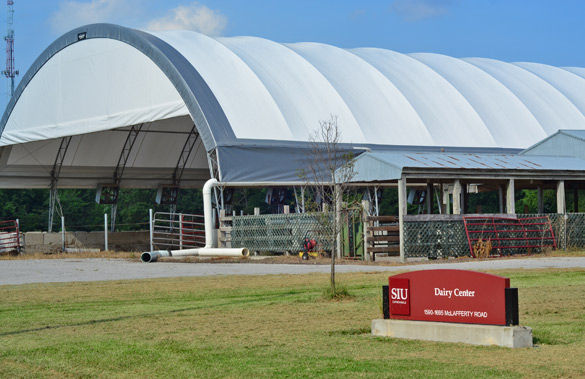University dairy cows sold over summer break

September 2, 2013
The entire herd of university dairy cattle were auctioned off in June, leaving a vacant barn where they used to reside.
Because of the auction, several agriculture students will now lack hands-on experience.
Advertisement
Many SIU students and community members have noticed the now-vacant barn on McClafferty Road that had housed the dairy cows of SIUC. One community member, Treena Wicoff, said she was afraid the university disposed of the cattle for financial reasons and they wouldn’t be returning the cattle in the future.
Mickey A. Latour, Dean of the College of Agriculture offers a different explanation.
The dairy cows have been auctioned off and there will not be any dairy cows at SIU this semester, he said. They have been sold for what he believes is in the best interest of the students and faculty.
Latour said the herd was auctioned off for multiple reasons. One reason being Amer AbuGhazaleh, associate professor of Animal Science Food and Nutrition, is currently on sabbatical. AbuGhazaleh works very closely with the dairy cows and he oversees much of the activity around them, such as feeding, cleaning, health, and diet, he said.
Latour said he thought it would be appropriate time to get a new herd because AbuGhazaleh is gone and will not be available to facilitate the activities.
“It was the perfect time to make a management decision to clean out the herd, clean up the facility and to put together a plan this fall so that we could bring new animals in either late fall or early spring,” he said.
Dairy labs will continue to meet but instead of working hands on with cows they will go on dairy tours where they can study state of the art equipment such as robotics, Rebecca Atkinson, associate professor, said. During this time the students will be allowed an opportunity to learn and experience more advanced technology in milking. They will learn the computer software for the robotics system of milking before they go back to hands on experience in the spring, she said.
Advertisement*
Latour said another reason for auctioning off the cows was their low milk production rate.
“Most dairy cows produce 80 pounds of milk per day and ours were at about 33 or 34 pounds per day,” he said.
The milk is important to the college of agriculture because it is sold and used for various expenses the program encounters while working with such large animals. The university lends support to the college of agriculture for the dairy cows but the college still need further funds to support the herd which they received from milk produced by the cattle to keep the dairy program running, he said.
“Turn-over of a herd is natural, you do a few at a time or a certain percentage of a herd just to rotate your livestock with a production herd,” said Bryan Young, professor and director of farms. “But the exception here is that we are not a production herd so we did everything all at once because there is a break in the action from teaching and research needs after AbuGhazaleh went on sabbatical.”
Student workers are responsible for caring for the cows. Now the cattle are gone for the fall, however student workers will still be allowed to keep the jobs. But instead of tending to animals they will be working to clean up, rebuild, and bring the facility up to par said Jarrett Nehring, director of farms operations.
“They’re pressure washing, they’re cleaning, they’re going through old file cabinets,” Nehring said, “We’re hauling manure and hay and building fences and gates.”
The students will have work throughout the whole semester in anticipation of the new cattle arrival in spring.
Advertisement







